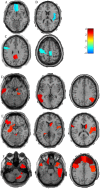Automatic classification of early Parkinson's disease with multi-modal MR imaging
- PMID: 23152757
- PMCID: PMC3494697
- DOI: 10.1371/journal.pone.0047714
Automatic classification of early Parkinson's disease with multi-modal MR imaging
Abstract
Background: In recent years, neuroimaging has been increasingly used as an objective method for the diagnosis of Parkinson's disease (PD). Most previous studies were based on invasive imaging modalities or on a single modality which was not an ideal diagnostic tool. In this study, we developed a non-invasive technology intended for use in the diagnosis of early PD by integrating the advantages of various modals.
Materials and methods: Nineteen early PD patients and twenty-seven normal volunteers participated in this study. For each subject, we collected resting-state functional magnetic resonance imaging (rsfMRI) and structural images. For the rsfMRI images, we extracted the characteristics at three different levels: ALFF (amplitude of low-frequency fluctuations), ReHo (regional homogeneity) and RFCS (regional functional connectivity strength). For the structural images, we extracted the volume characteristics from the gray matter (GM), the white matter (WM) and the cerebrospinal fluid (CSF). A two-sample t-test was used for the feature selection, and then the remaining features were fused for classification. Finally a classifier for early PD patients and normal control subjects was identified from support vector machine training. The performance of the classifier was evaluated using the leave-one-out cross-validation method.
Results: Using the proposed methods to classify the data set, good results (accuracy = 86.96%, sensitivity = 78.95%, specificity = 92.59%) were obtained.
Conclusions: This method demonstrates a promising diagnosis performance by the integration of information from a variety of imaging modalities, and it shows potential for improving the clinical diagnosis and treatment of PD.
Conflict of interest statement
Figures




References
-
- Alves G, Forsaa EB, Pedersen KF, Dreetz Gjerstad M, Larsen JP (2008) Epidemiology of Parkinson's disease. J Neurol 255 Suppl 5 18–32. - PubMed
-
- Adler CH (2011) Premotor symptoms and early diagnosis of Parkinson's disease. Int J Neurosci 121 Suppl 2 3–8. - PubMed
-
- Kashmere J, Camicioli R, Martin W (2002) Parkinsonian syndromes and differential diagnosis. Curr Opin Neurol 15: 461–466. - PubMed
-
- Piccini P, Whone A (2004) Functional brain imaging in the differential diagnosis of Parkinson's disease. Lancet Neurol 3: 284–290. - PubMed
Publication types
MeSH terms
LinkOut - more resources
Full Text Sources
Medical

